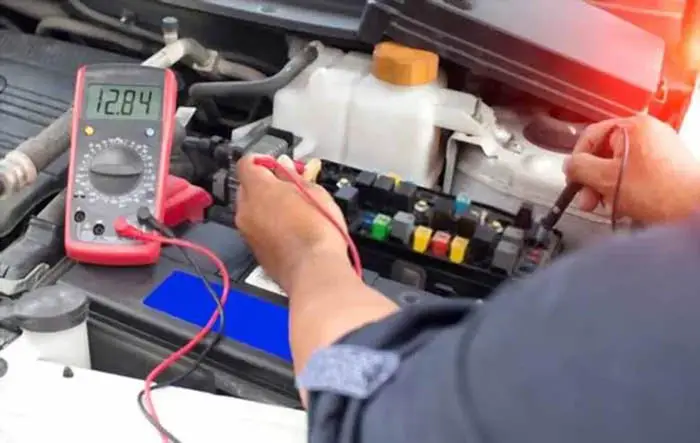
The function of a fuse is to protect the electrical system of a car to control the load of the circuit. The fuse is connected to the battery and the electrical system of the car, and the conductor inside of the fuse is responsible for interrupting the flow of current in the event of an overcurrent or short-circuit condition. When there is an overload of electricity, the fuse will “blow” or break, stopping the flow of electricity and protecting the car.
When working with electricity, it is important to use the proper fuse size. A small fuse would not provide enough protection and may cause a fire. If a fuse is too large, it may not blow in the event of an overload, which could also lead to a fire.
One common misconception about choosing the correct fuse size is that it’s only dependent on the load of the circuit. However, there are other factors that need to be considered such as wire size, ambient temperature, and the type of fuse holder being used.
The following steps can be used to determine the size of the fuse that is required for a particular application.
What is a Fuse Rating?
A fuse rating, also known as a current rating, is the maximum amount of electrical current that a fuse is designed to safely carry without interrupting the flow of electricity in an electrical circuit. It is measured in amps (A). The correct fuse rating must be chosen for the specific appliance or electrical circuit in order to prevent overcurrent, which can lead to damage or even a fire.
It is important to match the fuse rating with the ampacity of the wire used in the circuit. Recommended fuse size will ensure that the wire can safely handle the amount of current flowing through the circuit, and the fuse will trip and interrupt the flow of current in the event of an overcurrent situation, thus protecting the wire and fuse by preventing a fire.
Related Post: What Is A Car Fuse, How It Works: Ultimate Guide
How To Calculate What Fuse Size To Use

Generally, the fuse rating depends upon the circuit consumption. It depends on how much current a component consumes. The use of a wiring diagram can provide valuable information when determining the appropriate fuse size. When calculating the fuse size, it is important to consider the use of the circuit, whether it is for a car, solar installation, inverter, or charge controller. The manufacturer’s parameters, including the built-in wattage, should also be taken into account when calculating the fuse size or using a fuse sizing calculator.
Choosing the correct fuse size is important for the functioning of an electrical system. In order to select the right amperage fuse for a circuit. You first need to calculate the correct amount of current consumed by a component. You can determine the fuse size you need based on the current flowing through the circuit. For example, a 10A, 15A, or 30A fuse may be appropriate for a circuit, depending on the wire size and the intended use of the circuit. However, it is important to note that if the fuse blows too frequently, it may indicate a problem with the circuit, and a larger fuse size should be considered.
If you don’t know your project’s fuse size, you can identify it using the calculation of the standard electric power formula.
Drawn Current × Voltage ₌ Power
Drawn Current ₌ Power/Voltage
One thing I want to make you assure before we further dig deeper is that whenever you install a fuse in a circuit. It should be rated higher than the current drawn by the component and lower than the wiring size. Almost choose the fuse 125% higher in amperage rating than the component draws the current.
Suppose you want to add the right amperage fuse to an Auxiliary Fog Light of 100 watts in your car that runs on 12 volts. So, putting the values in the above Standard Electric Power Formula.
Drawn Current ₌ Power/Voltage
Drawn Current ₌ 100/12
Drawn Current ₌ 8.33 Ampere
In the above example, The Fog Light draws a current of 8.33 amps. You can multiply it by 125% or (1.25).
8.33 × 1.25 ₌ 10.4125 Ampere
You can also determine the size of the fuse with the calculator. It is important to note that this calculator should only be used by individuals having the appropriate working knowledge and understanding of electrical systems, based on industry standards. The calculator takes into account the American Wire Gauge (AWG) wire and is based on the smallest wire size in the circuit. This is because the fuse size should be based on the smallest wire in the circuit for optimal protection.
Now, you can go for the standard fuse rating, which is 10 amps. Using this working knowledge, you can find out the right amperage fuse for a circuit.
The next thing is if you don’t know whether to use a slow blow fuse or a fast blow fuse. If your component draws a high-inrush current at start-up then you should use a slow blow fuse. On the other hand, if your component does not draw a high-inrush current then you should go for a fast blow fuse.
In conclusion, the use of a fuse sizing calculator, based on industry standards including the appropriate working knowledge of electrical systems, is a valuable tool for determining the correct fuse size for a circuit. It is important to consider the wire size, intended use of the circuit, and manufacturer’s parameters when using the calculator to ensure optimal circuit protection because each manufacturer has its own standards. Misconceptions about choosing the correct fuse size can lead to damage to equipment and even safety hazards, so it is essential to use the right tools to size a fuse correctly and safely.
FAQs
The rule for choosing a fuse is to select a fuse with a current rating that is equal to or slightly higher than the maximum current that the circuit is expected to carry. This ensures that the fuse will properly protect the circuit from overcurrent and short circuit conditions, while still allowing normal operation of the circuit.
If you use a higher amp fuse than what is recommended in a car, it can lead to overloading of the circuit, causing damage, fires, and other safety hazards. It is important to always use the correct fuse rating for a circuit to ensure proper protection of the electrical system.
You can use a fuse sizing calculator, which takes into account the current flowing through the circuit, the wire size, and the intended use of the circuit in choosing a fuse size. The calculator is based on industry standards. It will give you the appropriate fuse you need while calculating fuse size.
If you are experiencing issues with the current flowing correctly in your circuit, it may be a sign that the fuse size is incorrect. You may need to use a fuse sizing calculator to determine the appropriate fuse size for your circuit based on industry standards and the wire size.
A circuit breaker is a safety device that automatically interrupts the flow of electrical current in a circuit in case of an overload or short circuit by allowing less current to pass which is in allowable limit. This prevents damage to the electrical equipment and protects against fire hazards. It can be used in addition to the fuse for more protection.
Related Post: Fuse Characteristics: The Science Of Characteristics Of Fuse Element In A Circuit
Sign Up




